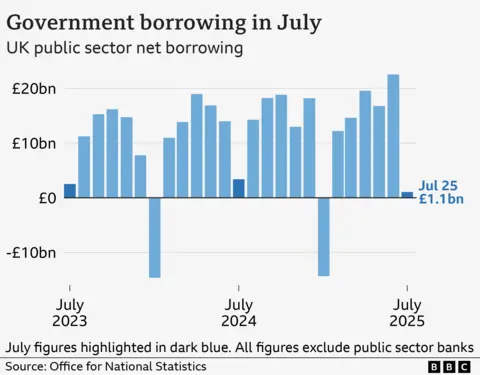Business reporter, BBC News
 Getty Images
Getty ImagesUK government borrowing was lower than expected in July, following a rise in tax and National Insurance receipts.
Borrowing – the difference between public spending and tax income – was £1.1bn in July, which was £2.3bn less than the same month last year, the Office for National Statistics (ONS) said.
It was the lowest July figure for three years, the ONS said, and was helped by a rise in self-assessed income tax payments.
Despite the lower-than-expected figure, analysts said the chancellor was still likely to have to raise taxes in the autumn Budget to meet her tax and spending rules.
Borrowing over the first four months of the financial year has now reached £60bn, the ONS said, which is up £6.7bn from the same period last year.
That total for the year so far is in line with what the Office for Budget Responsibility (OBR), the official independent forecaster, had predicted in March.
July saw income tax receipts rise by £4.5bn, the ONS said, and there was also an increase from National Insurance (NI) contributions. The rate of employers’ NI contributions was increased by the government in April.
Speaking to the BBC’s Today programme, Paul Dales, chief UK economist at Capital Economics, said the latest figures did not change the “predicament” Chancellor Rachel Reeves faces over what she will do in the Budget.
“We think she’s on track to miss her fiscal rule by something like £17bn which means she’ll need to raise that amount of money, or if she wants the same buffer against the fiscal rule as back in March of £10bn she might have to raise something like £27bn in the Budget, which is quite a big task.”

The chancellor is following two main self-imposed rules for government finances:
- day-to-day government costs will be paid for by tax income, rather than borrowing
- to get debt falling as a share of national income by the end of this parliament in 2029-30
Dennis Tatarkov, senior economist at KPMG UK, said the “longer-term picture for public finances remains challenging”.
“The coming Budget is likely to focus on addressing any potential shortfall against current fiscal targets, which we estimate at £26.2bn. However, the assessment of the shortfall crucially depends on changes to the OBR’s forecast.”
Darren Jones, Chief Secretary to the Treasury, said: “Far too much taxpayer money is spent on interest payments for the longstanding national debt.
“That’s why we’re driving down government borrowing over the course of the parliament – so working people don’t have to foot the bill and we can invest in better schools, hospitals, and services for working families.”




